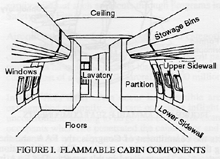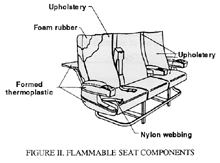Fire Research
Summary
Forty percent of the passengers who survive the impact of an aircraft accident subsequently die in a postcrash fire. Unless this percentage is reduced or the accident rate decreases, the number of fire fatalities will increase by four percent each year with the expected growth in passenger air traffic. Compounding the upward trend in aircraft fire fatalities is the additional fire load associated with the one percent annual growth in the use of lightweight, combustible polymers and composites for aircraft interiors and structures. Current aircraft utilize several tons of combustible plastics for cabin interior components - a fire load comparable to the equivalent weight of aviation fuel. The cabin fire load will approximately double in the very large (800 passenger) airplanes under development by airframe manufacturers unless ultra fire-resistant materials become available.

[Click on image for a larger view]
The use of materials with improved fire resistance (relative to commodity plastics) was mandated by the FAA in 1987 with requirements for the burning rate and flame spread of seat cushions, and in 1990 with the establishment of regulations limiting the heat release rate of large area cabin interior components. These regulations provide an additional 2-4 minutes of cabin escape time in the event of an aircraft accident involving a post crash fuel fire outside the cabin. Further improvement in cabin material fire-safety is unlikely without government-sponsored research because the market is limited to passenger aircraft cabins and does not justify the research investment by private industry. In response to this situation the FAA has initiated a proactive, long range research effort in Fire Resistant Materials to identify and develop the enabling materials technology for a cost-effective, fireproof passenger aircraft cabin. In combination with other fire-safety system improvements, ultra-fire-resistant materials will eliminate catastrophic inflight fuselage fires and provide a minimum of 10 minutes of passenger escape time in a postcrash fire.
The objective of the Fire Resistant Materials program is to eliminate burning cabin materials as a cause of death in aircraft accidents. Research is basic in nature and focuses on the synthesis, modeling, processing, and characterization of new materials and materials combinations. In accord with the recommendations of the National Research Council¹s Materials Advisory Board in their report ³Fire- and Smoke-Resistant Interior Materials for Commercial Transport Aircraft,² (NMAB-477-1, National Academy Press, 1995) near term technical approaches include modification of specialty and commodity polymers using additives and processing routes. Databasing of materials fire performance in micro-, bench-, and full-scale testing supports science-based studies of polymer combustion and identifies critical fire performance properties to guide development. Long term activities include the synthesis of new, thermally stable, low fuel value organic/inorganic polymer systems. The synthesis effort is supported by fundamental research to understand polymer combustion and fire resistance mechanisms using numerical and analytic modeling and the development of new characterization techniques.
The output of this research will be an order-of-magnitude reduction in cabin fire hazard relative to current cabin materials at comparable cost and functionality. Since the heat release rate of burning materials is the primary fire hazard indicator, the technical objective is to develop low-cost, lightweight, serviceable polymers and composite materials with zero heat release rate as measured by FAR 25.853(a-1), "Heat Release Rate Test for Cabin Materials." Materials with a zero heat release rate will provide sufficient passenger escape time in a post crash fuel fire to ensure survivability. With respect to the 1996 baseline for new aircraft, individual fire-resistant materials will demonstrate a 50% reduction in heat release rate by the year 2002. Prototype cabin components fabricated from combinations of fire-resistant materials will demonstrate zero heat release rate by the year 2010. The potentially higher initial cost of fire-resistant cabin materials will be offset by user financial incentives which include shorter process cycles, better durability, and lower heat release rate.
 Federal Aviation Administration
Federal Aviation Administration
